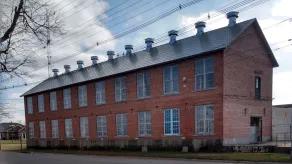Vinton was home to one of the first canning operations west of the Mississippi River, and it was referred to by residents and regional media as the unofficial Sweet Corn Capital of the U.S. Vinton boasted its ability to produce food for the rest of the country in the early 1900s.
The facility is linked to some of the most well-known names in Vinton history. It was both one of the first of its kind and one of the largest. The operation continued producing millions of cans each year until the 1950s, when farmers switched to growing hybrid corn instead of sweet corn.
A state historical assessment of the site included the following: The major historic resource in the neighborhood is the factory warehouse at 201 1st Avenue, which operated under various owners and business names through the years. The earliest available Sanborn Map shows the warehouse as S.H. Watson Canning Company in 1885.
Later maps show the building as the Cedar Valley Packing Company in 1892; the Vinton Canning Company in 1899, 1906, 1913, and 1921; and the Iowa Canning Company in 1941. The original business appears to have been established by Samuel H. Watson, a Vinton pioneer, successful banker, and holder of school and town offices.
During the 1890s the canning factory operated under several names with a change to the Kelley Canning Company in ca. 1892. W.C. Ellis, Frank G. Ray and H.B. Kelley served as its owner-officers. In 1895 it was reorganized as the Vinton Canning Company, one of several plants operated as part of the Iowa Canning Company. In the 1890s it was described as the first corn canning factory west of the Mississippi.
A decade later in 1905 it had branch factories in La Porte City, Garrison and Shellsburg processing nearly 9 million cans of corn annually under 23 brands. The Vinton operation's capacity alone exceeded 3 million cans annually including such brands as "Vinton Blue," "Vinton Yellow," "Vinton Red," "Vinton Green," "Vinton Black," "Iowa's Pride," and "Iowa Chief."
250 workers were employed during the peak season before World War I.
Producing 11 million cans of corn, 1,300 workers earned a total of approximately $100,000 over a span of just more than four weeks. 6,600 acres of area farmland was devoted to sweet corn varieties such as Evergreen and Country Gentleman according to a 1925 newspaper article. It cited five local facilities, including Vinton's Seed House.
The Seed House has been owned by several local owners over the course of its history. Just in the last 30 years, it's changed hands from the Junge family, then it was sold to Ideal Industries followed by the Mike Elwick family and then it sold to in 2002 to Joe and Peggy Schott. Unfortunately, Joe passed away leaving Peggy with the burden of the property.
In recent years, the Seen House has been damaged by the Flood of 2008. Following that, it sustained damage during the July 2011 Derecho, the Schotts received a $38,500 grant from the Iowa Department of Cultural Affairs to help cover the estimated $68,000 cost of fixing the roof.
In 2012, the Seed House joined the National Register of Historic Places.
Most recently the building and attached buildings, have been on the radar of the city for their dilapidated condition. About four years ago, Joe Schott had come before the council with plans to clean out the buildings and to fix them up. Last year, unfortunately, Joe's health declined to leave the burden on his wife and son.
The duo had come again before the council in the last couple of months trying to find a solution. Racking up a lien against the property for $1,722 from the city, the building is on shaky ground. Because of additional damage to the structure during the flood and wind storm, repairs and maintaining the building had become too much for the couple.
As a result, Vinton condemned the property in November.
There is no shortage of people wanting to save it, and emotions are high about possibly losing the structure, but the cost to save it is prohibitive for most.
The "Seed House" as the building is referred to, has now been added to the list of " 2023 MOST ENDANGERED PROPERTIES" by Preservation Iowa. It's among six properties on the endangered historic and special buildings and sites across Iowa for 2023.
The list is compiled to bring attention and potential grants and other resources to save the properties. Of the six on the list, the Seed House came in as number three.
The organization listed the following Most Endangered properties for 2023:
William Fletcher King Memorial Chapel, Mt. Vernon, Linn County
Wilson Middle School, Cedar Rapids, Linn County Iowa
Canning Company Seed House, Vinton, Benton County
Hastie Farmhouse, Carlisle, Warren County
George House, North Liberty, Johnson County
207 Lafayette St., Waterloo, Black Hawk County
They also said, "Preservation Iowa's Most Endangered Property program was started in 1995 and was implemented to educate Iowans about the special buildings and historic sites that are slowly and gradually slipping away from us. Over the past 25 years, Preservation Iowa has designated over 200 archaeological sites, commercial buildings, homes, churches, landscapes and a variety of other properties in 69 Iowa counties.
The Most Endangered Properties program helps to bring to the public's attention the risks to a
designated historic property and introduces owners of an endangered property to preservation
advocacy and resources that can help preserve their historic property. Additionally, there have
been interest groups who have been able to use the designation as a mechanism to leverage other
financial resources to restore and preserve properties. For more information about the Most
Endangered Program, check out Preservation Iowa's website at www.preservationiowa.org or
contact Preservation Iowa at info@preservationiowa.org."
.

Comments
Submit a CommentPlease refresh the page to leave Comment.
Still seeing this message? Press Ctrl + F5 to do a "Hard Refresh".